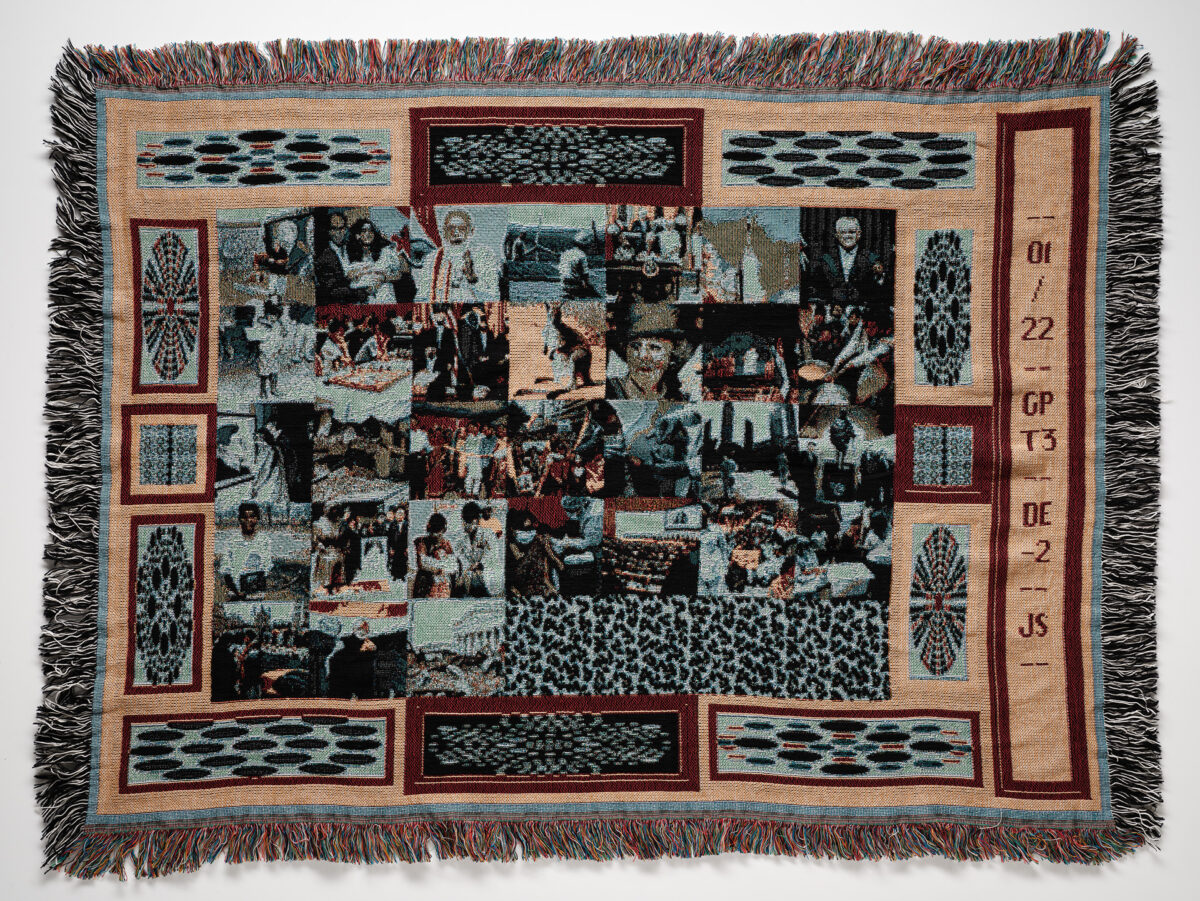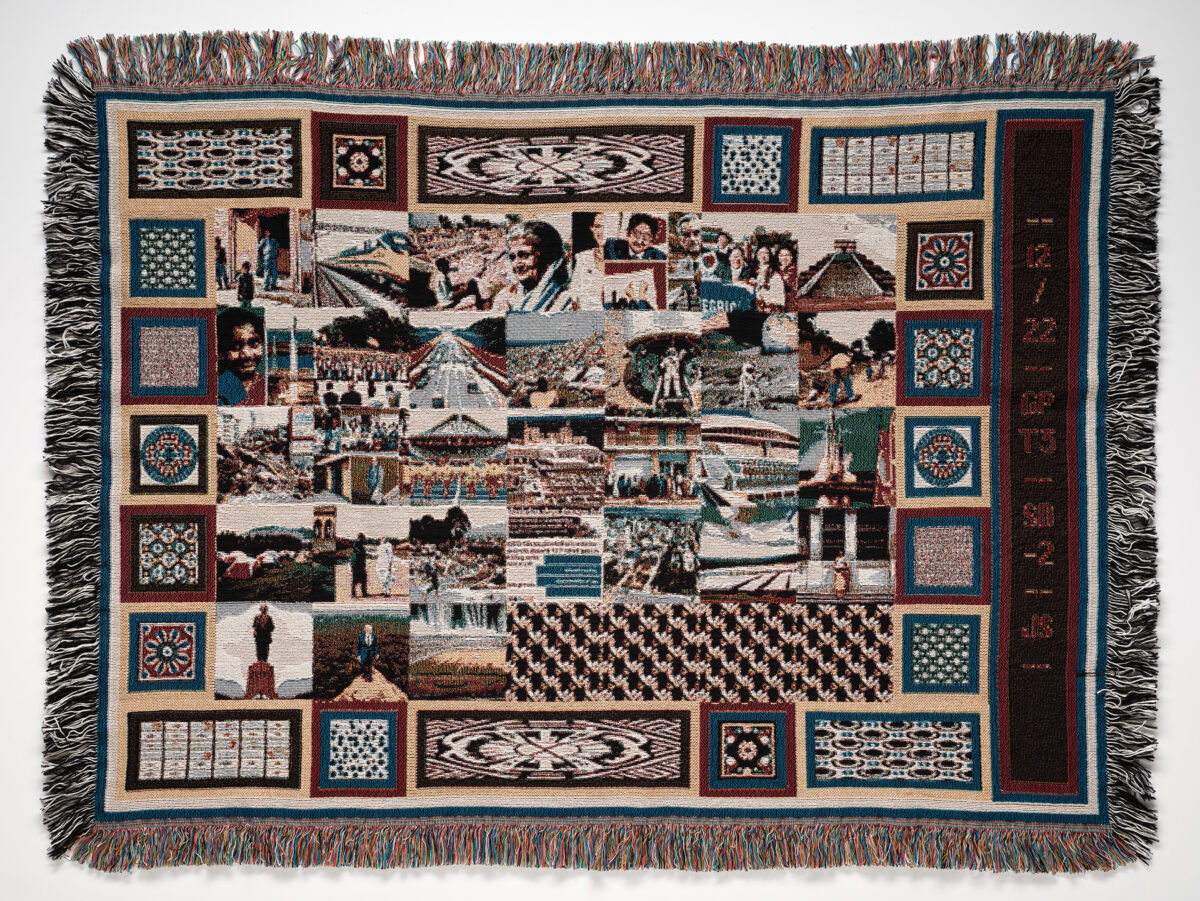Recently, I visited an exhibition that fired some undeveloped synapses in my brain. I like the idea of being flummoxed by art, but my recent derailment was coupled with feelings of ambivalence: the artwork was a collaboration between the artist and a selection of generative artificial intelligence programs. By the way, the artist was the creative generator.
The artist – the person who used his wisdom, creative experience, endeavour and personal struggle – was Jonny Scholes. (I’m stressing the role of the creator because I’m fearful of AI run by corporations to “scrape” and exploit the creativity of others because I see it as subverting the unconscious human spirit that underpins human existence and creativity; paraphrasing Nick Cave.)
When you meet an artist who is new to you, you hope for a fresh vision that wakes or shakes you up. Jonny Scholes did just that and I also learned a lot – an additional and unexpected gift.
The exhibition was a deceptively simple hang of 16 tapestries, in Social, a gallery space run by Salamanca Arts Centre, in Hobart, Tasmania. Each tapestry measures 132 x 94 cm or about the size of a small prayer mat.
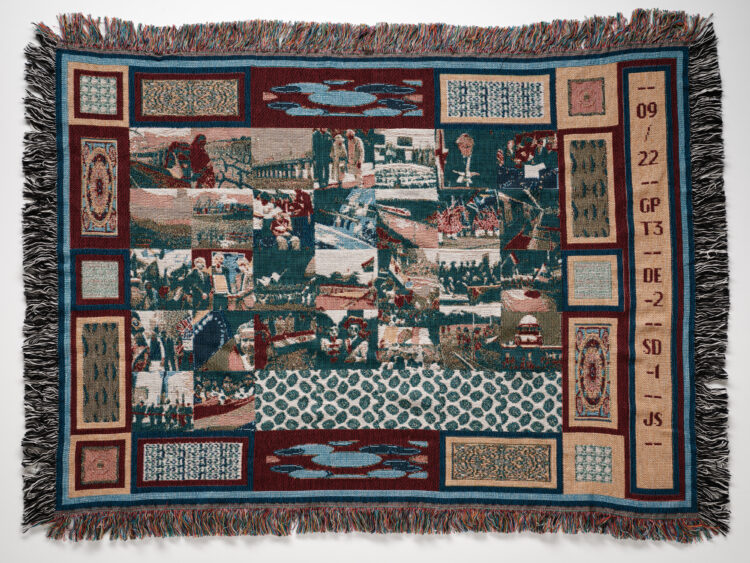
The right-hand border image was computer generated by Jonny, stating the date and which edition of generative-AI created the monthly news stories and images.
Jonny called the exhibition “Interpreted”. In his gallery notes he wrote that his tapestries are a link back to medieval wall hangings often made by female weavers and embroiderers who were interpreting the designers’ instructions.
A week or so later I went to talk with Jonny in his graffiti paint warehouse, Vibrance.
I told him that I found his tapestries entrancing, but also disconcerting because I was a little intellectually “sniffy” about the artificial creator.
Jonny responded seriously to my prejudices, explaining that while he is a user of AI, he has concerns but rather than being for or against it he would rather see how we manage and work with it. As he points out, it uses algorithms that have been used to exploit our thoughts for more than 10 years through Facebook, Google and Amazon.
It was in early 2022, he explained, when he came up with the tapestry idea after seeing an exhibition of East Asian weavings at the National Gallery of Victoria, in Melbourne. Some were hundreds of years old and used ancient traditional designs but also incorporated signs and symbols of the early colonisers – the Dutch and the French. For most people of the time these stories were readable but to our 21st century eyes, they are unknowable.
The Bayeux Tapestries, for example, could be regarded as an elaborate press release telling the story of William Duke of Normandy’s 1066 invasion and conquering of England. (Despite being described as tapestries, the Bayeux works are embroidered.) They depict battle scenes and mythical creatures, as imagined by the people sewing the work. To us, much of the symbolism and even the story is a mystery.

A scene from the Bayeux Tapestry depicting Bishop Odo rallying Duke William’s army during the Battle of Hastings, in England, in 1066.
And that interested Jonny. He wanted to use AI to explore how these ancient storied tapestries, full of interpreted meaning to their creators and used to announce their ability and prowess, are the antecedents to today’s images, which artificial intelligence is retrospectively distorting in real time.
Looking back to see forward, was something the Roman stoic philosopher, Seneca, thought we needed to do. So, nothing new here.
“I took all of the news headings shared on a day – thousands of them, and I gave them to a text generation AI tool and asked it to summarise the world’s top [daily] news story into two sentences.” He also asked it to create one daily image to represent those sentences.
He used an automated computer database, the GDELT Project, which continually reviews all international news articles as they are published and then turns that into a format that is machine readable. GDELT also tries to ensure balance in the news gathering by using so-called objective reporting news services such as Associated Press, Reuters, BBC, News of India, but not, for example, RT – the Russian propaganda service. The artificial intelligence program may choose to edit out any form of nudity, any form of sexuality, or anti LGBTQI content to prevent propaganda slogans being created by bots.
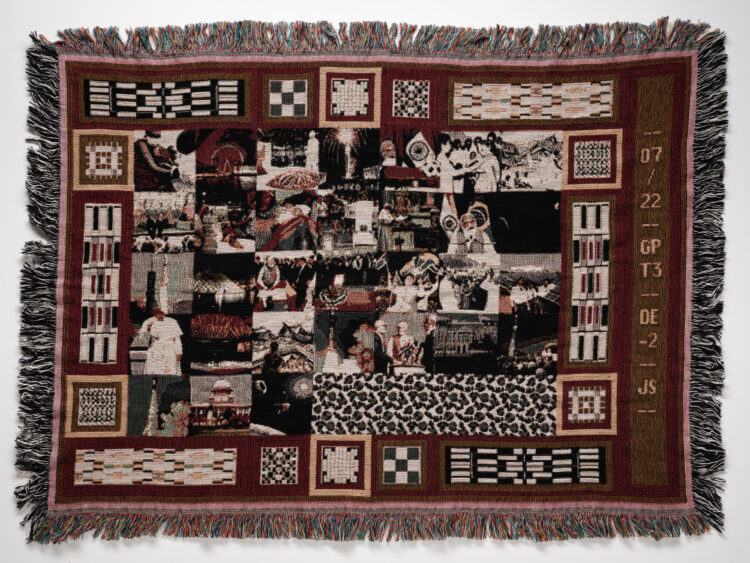
The created AI images often make it difficult to decipher what particular news event has been determined for each day.
“At that point, [AI] is making a decision about what can and can’t be in those two sentences. All I say is ‘summarise the following headlines into the important news of the day’…I’m illustrating how the AI model interprets that statement input. That is frankly the entirety of the artistry, in a way; the terms of the concept.”
This happened over 16 months, and during that time the models were improving. As Jonny explains, “I was illustrating how different models interpret what an important story is. It had a news set to look over and it used its internal logic – basically a probability engine – to decide which news was important enough to illustrate. Which is a reflection of all of the billions of news articles it learned from.”
He ran the project from January 2022 to April 2023, and AI incorporated each image into a tapestry design for each month. Then, autonomously, it sent the final results off to a site in the US to be woven. And these eventually arrived in Hobart for Jonny to discover, for the first time, what he was exhibiting.
As you scan each woven cotton collage, you first notice a border of repetitive and frequently kaleidoscopic patterns created entirely by the computer. (Jonny also created a panel detailing the month and edition of the AI tool he used.) You begin to recognise the grid of news images, or rather find yourself “scraping” your own memory for familiar shapes and you make a leap as to what you are seeing: Queen Elizabeth II (the hat, the head held at a certain angle and a slight stoop), Nelson Mandela (the broad face, high forehead, those heavy-lidded eyes), President Biden the slender face with no features and suited body – possibly the American flag beside him. Is that the Statue of Liberty? Is that Saddam Hussein or just a composite face with a moustache like his?
The woven images are not only “pixilated” by the weaving but by the apparent initial inability of the “creator“ to understand what it is creating. It is our human memory and history of learning that allows our brain to make that leap to recognition, and hopefully, understanding. We have a context in which to frame the images, AI does not.
To me, the images in the last tapestry for April 2023 are the most deftly defined and at the same time the least readable. I recognised an image – such Chichén Itzá in Mexico; or a small child’s face; or a crowd scene. I was less clear on what stories they each represented. But that could merely be my limited knowledge of international stories beyond my area of interest.
I was still struggling to understand how generative AI actually created the images, so Jonny talked me through the process. AI is not technically creating a composite image.
“What they are is a massive matrix of probabilities that describe how certain parts of words – not even full words – correlate with certain clusters of pixels. It creates the first pass – an image containing noise which is thousands of random colours in a square. Then it looks at that and says ‘do any these look like the cluster of pixels associate with bits of words?’
“The way I’ve best described it is to imagine you’ve never seen a boat before and I show you a hundred pictures of a boat and I show them to you for a couple seconds and then I put them face down and then I ask you to draw a boat. That’s kind of what it’s doing.
“Rather than me showing you hundreds of boats, cutting them into hundreds of pieces and then saying create a boat from that. That’s the difference.”
And what is his exhibition “Interpreted” revealing? “I’m illustrating the erosion of information as it is captured and distilled and re-disseminated,” he explains.
Each tapestry forces the viewer to “unpick” a scene, and there are potential inaccuracies in each. I found the exhibition rather frightening and also compelling.
What do these contemporary tapestries say about our future knowledge? For me it is another disruption in our increasingly pixilated, siloed and self-referential lives. How do we establish the truth when we no longer believe, or truly understand, what we are seeing and who or what created it – not only the past but also the present.
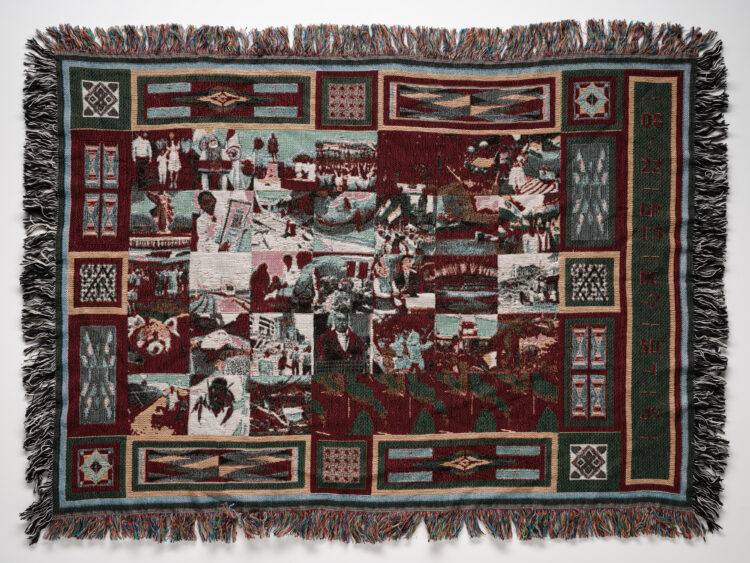
Jonny Scholes
All photography: Peter Whyte
Biography
Jonny Scholes was born in 1991 in nipaluna, Hobart, where he lives and works.
He resists any genre art labels and works across painting, new media, sculpture, generative art, internet art and installation.
He was brought up with art at the core of everyday life with one filmmaker parent and the other a novelist. It was this lifestyle that led him to explore a public art life from an early age, becoming a street artist in his early teens and then regularly exhibiting work from the age of 15. Jonny never went to art school, choosing instead to embed himself in the art studios of local artists to learn alongside them.


